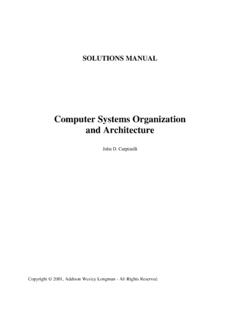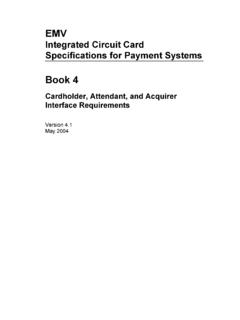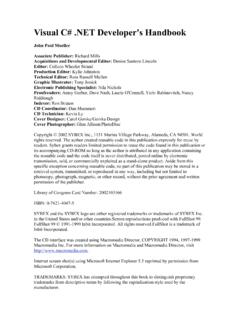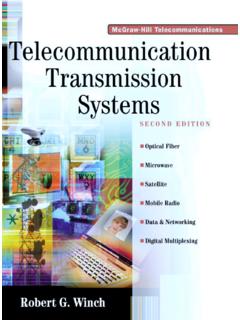Transcription of Smart Antenna Systems - pudn.com
1 Smart Antenna Systems Definition A Smart Antenna system combines multiple Antenna elements with a signal-processing capability to optimize its radiation and/or reception pattern automatically in response to the signal environment. Overview What does an Antenna do in a telecommunications system ? It is the port through which radio frequency (RF) energy is coupled from the transmitter to the outside world and, in reverse, to the receiver from the outside world. Antennas have been the most neglected of all the components in personal communications Systems . Yet, the manner in which energy is distributed into and collected from surrounding space has a profound influence on the efficient use of spectrum, the cost of establishing new networks, and the service quality provided by those networks.
2 The following tutorial is an introduction to the essential concepts of Smart Antenna Systems and the important advantages of Smart Antenna system design over conventional omnidirectional approaches. The discussion also differentiates between the various and often dissimilar technologies broadly characterized today as Smart antennas. These range from simple diversity antennas to fully adaptive Antenna array Systems . Topics 1. A Useful Analogy for Adaptive Smart Antennas 2. Antennas and Antenna Systems 3. What Is a Smart Antenna system ? 4. The Goals of a Smart Antenna system 5. Signal Propogation: Multipath and Cochannel Interference 6. The Architecture of Smart Antenna Systems 7. Who Can Use Smart Antenna Technology? Self-Test Web ProForum tutorials Copyright The International Engineering Consortium 2/29 Correct Answers Glossary 1.
3 A Useful Analogy for Adaptive Smart Antennas For an intuitive grasp of how an adaptive Antenna system works, close your eyes and converse with someone as they move about the room. You will notice that you can determine their location without seeing them because of the following: You hear the speaker's signals through your two ears, your acoustic sensors. The voice arrives at each ear at a different time. Your brain, a specialized signal processor, does a large number of calculations to correlate information and compute the location of the speaker. Your brain also adds the strength of the signals from each ear together, so you perceive sound in one chosen direction as being twice as loud as everything else. Adaptive Antenna Systems do the same thing, using antennas instead of ears.
4 As a result, 8, 10, or 12 ears can be employed to help fine-tune and turn up signal information. Also, because antennas both listen and talk, an adaptive Antenna system can send signals back in the same direction from which they came. This means that the Antenna system cannot only hear 8 or 10 or 12 times louder but talk back more loudly and directly as well. Going a step further, if additional speakers joined in, your internal signal processor could also tune out unwanted noise (interference) and alternately focus on one conversation at a time. Thus, advanced adaptive array Systems have a similar ability to differentiate between desired and undesired signals. 2. Antennas and Antenna Systems Antennas Radio antennas couple electromagnetic energy from one medium (space) to another ( , wire, coaxial cable, or waveguide).
5 Physical designs can vary greatly. Web ProForum tutorials Copyright The International Engineering Consortium 3/29 Omnidirectional Antennas Since the early days of wireless communications, there has been the simple dipole Antenna , which radiates and receives equally well in all directions. To find its users, this single-element design broadcasts omnidirectionally in a pattern resembling ripples radiating outward in a pool of water. While adequate for simple RF environments where no specific knowledge of the users' whereabouts is available, this unfocused approach scatters signals, reaching desired users with only a small percentage of the overall energy sent out into the environment. Figure 1. Omnidirectional Antenna and Coverage Patterns Given this limitation, omnidirectional strategies attempt to overcome environmental challenges by simply boosting the power level of the signals broadcast.
6 In a setting of numerous users (and interferers), this makes a bad situation worse in that the signals that miss the intended user become interference for those in the same or adjoining cells. In uplink applications (user to base station), omnidirectional antennas offer no preferential gain for the signals of served users. In other words, users have to shout over competing signal energy. Also, this single-element approach cannot selectively reject signals interfering with those of served users and has no spatial multipath mitigation or equalization capabilities. Omnidirectional strategies directly and adversely impact spectral efficiency, limiting frequency reuse. These limitations force system designers and network planners to devise increasingly sophisticated and costly remedies.
7 In recent years, the limitations of broadcast Antenna technology on the quality, capacity, and coverage of wireless Systems have prompted an evolution in the fundamental design and role of the Antenna in a wireless system . Directional Antennas A single Antenna can also be constructed to have certain fixed preferential transmission and reception directions. As an alternative to the brute force method of adding new transmitter sites, many conventional Antenna towers Web ProForum tutorials Copyright The International Engineering Consortium 4/29 today split, or sectorize cells. A 360 area is often split into three 120 subdivisions, each of which is covered by a slightly less broadcast method of transmission. All else being equal, sector antennas provide increased gain over a restricted range of azimuths as compared to an omnidirectional Antenna .
8 This is commonly referred to as Antenna element gain and should not be confused with the processing gains associated with Smart Antenna Systems . While sectorized antennas multiply the use of channels, they do not overcome the major disadvantages of standard omnidirectional Antenna broadcast such as co-channel interference, which will be described more fully in Topic 5. Figure 2. Directional Antenna and Coverage Pattern Antenna Systems How can an Antenna be made more intelligent? First, its physical design can be modified by adding more elements. Second, the Antenna can become an Antenna system that can be designed to shift signals before transmission at each of the successive elements so that the Antenna has a composite effect. This basic hardware and software concept is known as the phased array Antenna .
9 The following summarizes Antenna developments in order of increasing benefits and intelligence. Sectorized Systems Sectorized Antenna Systems take a traditional cellular area and subdivide it into sectors that are covered using directional antennas looking out from the same base station location. Operationally, each sector is treated as a different cell, the range of which is greater than in the omnidirectional case. Sector antennas increase the possible reuse of a frequency channel in such cellular Systems by reducing potential interference across the original cell, and they are widely used for this purpose. As many as six sectors per cell have been used in practical service. When combining more than one of these directional antennas, the base station can cover all directions.
10 Web ProForum tutorials Copyright The International Engineering Consortium 5/29 Figure 3. Sectorized Antenna and Coverage Patterns Diversity Systems In the next step toward Smart antennas, the diversity system incorporates two Antenna elements at the base station, the slight physical separation (space diversity) of which has been used historically to improve reception by counteracting the negative effects of multipath (see Topic 4). Diversity offers an improvement in the effective strength of the received signal by using one of the following two methods: switched diversity Assuming that at least one Antenna will be in a favorable location at a given moment, this system continually switches between antennas (connects each of the receiving channels to the best serving Antenna ) so as always to use the element with the largest output.

















